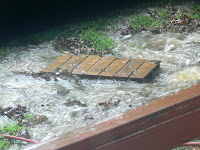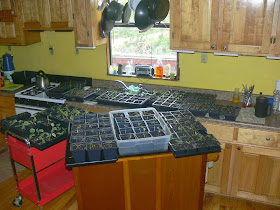 |
| This guy was right across the road from this year's Turkey Palooza house. |
This summer we partnered with Carol and Ron, some friends in our self-reliance group, to raise meat chickens. We built a chicken tractor together at their property, ordered in 40 chickens to raise from chicks and planned to butcher them at about 10 weeks, which happened to be when we were returning from Turkey Palooza. Upon our return, we scheduled The Day with our friends. We planned to kill and dress out all the birds in one fell swoop if we could.
 |
| Our chickens see the door is open on 'The Day' and think they are getting fed. |
 |
| Cooling down the new freezer by adding some frozen turkeys saves on power from the batteries. |
If an off-gridder raises a bunch of meat chickens she's going to want a freezer to store them in before canning. If you give her a freezer, she is going to want 6 frozen turkeys to quickly cool down the freezer when she brings it home. If you give her the six turkeys she is going to make a lot of bone broth to can. If she makes a lot of bone broth she is going to want a lot more canning jars. If you give her canning jars, she is also going to cook and can all her frozen chickens.... you get the idea - it has felt like an unending process. And yes, we bought a small freezer that we can run off our solar system (in sunny weather). Our plans are to use it sporadically as needed, like when we find good sales on meat. And as a side benefit, or what I have been calling a Christmas Miracle, we currently have ice cream at our house!
Back to The Day. I must admit I had a lot of trepidation as to how this newest adventure in homesteading would go. None of us had ever done it before. Carol admitted up front that she did not think she would be much help, and while Alan was game to try, we had already had discussions that once we started hunting game I would probably be the one cleaning it. Our skill sets actually compliment each other in our various chores around the property and this was one area we both agreed was more in my ballpark than Alan's. Albeit, if it was worse than I thought it was going to be, he would owe me big time!
We woke on The Day and donned what we have since been referring to as our 'chicken clothes'. We packed up the items we thought might be needed to make this a more successful venture and drove to Ron & Carol's. As we got out of the truck, Alan said 'Hello, Chickens' and I asked if we shouldn't be saying 'Good-bye' to them instead. That was just the start of the some-what macabre humor we injected throughout the day.
Ron already had water on to heat up, the plucker ready to go and a cleaning station set up. First item on the agenda was to determine who was doing what, well actually first we had to decide what actually needed to be done. Here is the basic process:
 |
| Alan and Ron got the messiest jobs that day. |
 |
| Adding chickens to the 'hanging tree' to drain. |
As steps 1& 2 could be a bit traumatic (for us - not the birds), I think we may try the killing cone method in the future which keeps the birds calm and is less messy.
 |
| Ron using the plucker. You can see the scalding pot in the fore-ground. |
4. Even at optimal temperature the plucker did not remove all the feathers, I would estimate that it removed 75-80% and those that remained were mostly on the legs and wings. So, the next step was plucking the remaining feathers by hand. I would start this tedious process while Ron was running each batch of 4 chickens over the plucker. Then he would join me to finish up the hand plucking.
5. The step I was dreading - eviscerating (gutting). I had prepared as best I could by reading up on the technique in several of our homesteading books and googling it as well. After a bit of muddling through on the first one, I found it was not complicated at all. You just have to take special care in several areas to not nick any internal organs (i.e., intestines) to keep the bird clean (i.e., no escaping poop). To aid in this goal we did stop feeding the birds 24 hours before The Day.
 |
| Yep, check this off my bucket list. |
For those of you who plan on eviscerating a bird in the near future, here is the order I found most natural for me:
- don vinyl gloves.
- bend the legs at the joint at the top of the feet, where rough yellow skin meets feather. Using a sharp knife, cut between the joint to remove the feet.
- use garden pruners to cut of the wing tips at the first joint in the wings, my gardens pruners were a great addition for The Day but, being garden shears, they did complain that they were vegetarians.
- using a sharp knife, carefully cut a slit through the skin below the breastbone and running horizontally from inside thigh to inside thigh and stretch the opening with your hands.
- at this point, after some experimentation, I decide I liked to turn the bird over and cut around the vent (tail) being careful to not cut the lower intestine that is connected to the vent.
- I then used my pruners to carefully snip the back bone where I made the cut around the vent, this way, when it came time to removed the innards the vent was already attached to them and not attached to the bird.
- turn the bird back over so the cut/opening under the breast bone is facing you and stick your hand into the opening and work your hand around the cavity walls to break the innards free. There really is not much connectivity, it just feels a bit weird and warm.
- wrap you hand around the innards and pull them out through the opening, at first I was afraid of breaking open the intestines or some other entrail that may cause a lot of grossness but they are actually quite tough and will not tear when using your hands. You will actually need to pull with a fair amount of force to dislodge the wind pipe.
- as the entrails leave the body, verify the vent you cut away is also fully detached from the bird, if not, carefully trim around it some more.
- before the entrails fall into the discard bucket you may choose to pull the heart, gizzard and liver to save for giblets. Note, if saving the liver very carefully remove the gall bladder from the lower side of the liver. The gall bladder is greenish in color and if broken will taint the taste of anything it's come in contact with.
- now rotate to chicken to work on the neck.
- remove the skin on the neck by cutting the skin down along the neck and around the lower edge next to the chicken body.
- remove the crop which is a small sack on the chicken body next to the neck.
- you may see some wind pipe remaining at this end of the bird, it look a bit like a segmented worm and can be removed by pulling it out of the neck opening.
- use the garden pruners to cut the neck off as close to the body as you can, save the neck for making bone broth.
- rinse the bird and place in a cooler filled with ice water. After the birds had rested a bit we transferred them to a second cooler as the water in the first cooler was being discolored by slight amounts of blood and also had a few floating feathers that had stuck to the birds.
 |
| Cooling down the birds. |
Wait, you may have noticed I did not mention Carol's duties for the day. She was our 'gopher' and she quickly volunteered to go for ice - twice.
By the way, we are going over to Ron & Carol's for Christmas Eve dinner and the only request we had was 'no chicken'. Carol said that ham is on the menu - they recently picked up a pig they had purchased and had processed by the meat packer. I wonder how many steps there are in butchering a pig, it may be time for some more research....
________________________________________________
 |
| Fresh broth on the left - canned broth on the right. Canning the broth gives it a rich golden color. |
When not planning to can the broth, I only use 1 chicken. The broth keeps in the fridge for about a week and this makes enough broth for Alan and I to each have a cup at night and use it up before any of it spoils. When making broth to can I start with either one turkey or three chickens.
Ingredients listed for one chicken
[brackets show amount for 3 chickens or 1 turkey]
1 chicken [3 chickens or 1 turkey]
1 gallon water [2 1/2 gallons water]
3-4 carrots [6-8 carrots]
1 onion [2 onions]
3-4 stalks of celery [6-8 stalks of celery]
3 garlic cloves [6 garlic cloves]
 |
| Celery, carrots, onion, garlic and crystallized ginger. |
3-4 Tablespoons kosher salt [1/4 to 1/3 cup kosher salt]
2-3 Tablespoons apple cider vinegar [1/4 cup apple cider vinegar]
As you can seen, most ingredients are an approximation. I like celery and tend to add a little extra, you can adjust the amount to taste.The important ingredient to not leave out is the apple cider vinegar, it helps draw the nutrients out of the bones.
 |
| Multi-tasking: pressure canning on the left and making the next batch of bone broth on the right. |
Cut carrots and celery into 2 to 3 inch segments.
Thicker carrot segments can also be halved length wise.
Halve garlic cloves.
Add all ingredients to a large stock pot.
Bring pot to the point of boiling and then reduce to a low simmer and simmer for 3-4 hours
(You may take out the bird when fully cooked, remove all meat to save and place the carcass back in the simmering pot, but I usually simmer the full bird the entire time and then use the meat for chicken & dumplings, soups and stew.)
Remove bird, allow to cool enough to pull the meat from the bones, you will notice the bones are very brittle.
 |
| I thought I was well stocked with canning jars, but I needed to add some to my pantry for this canning session. |
Strain the broth. I use a mesh sieve, but you can use cheesecloth if you prefer a clearer broth
If canning, pressure can at 10 pounds pressure (adjust for altitude) 90 minutes for quarts, 75 minutes for pints.
 |
| This must have been one of the first turkeys.... because I am still smiling :-) |







































